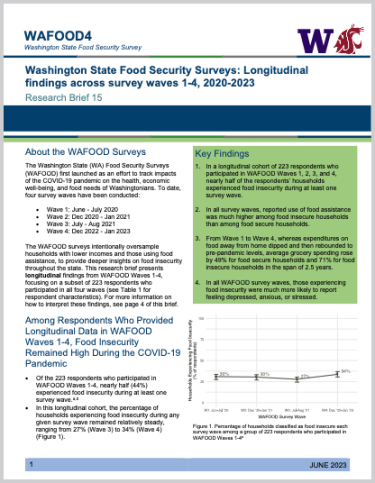WAFOOD Brief 15 – Washington State Food Security Surveys: Longitudinal findings across survey waves 1-4, 2020-2023
Published August 3, 2023, this research brief presents longitudinal findings from WAFOOD Waves 1-4 (June 2020-January 2023), focusing on a subset of 223 respondents who participated in all four waves.
Initial Findings
In a longitudinal cohort of 223 respondents who participated in WAFOOD Waves 1, 2, 3, and 4, nearly half of respondents’ households experienced food insecurity during at least one survey wave. In all survey waves, reported use of food assistance was much higher among food insecure households than among food secure households. From Wave 1 to Wave 4, whereas expenditures on food away from home dipped and then rebounded to pre-pandemic levels, average grocery spending rose by 49% for food secure households and 71% for food insecure households in the span of 2.5 years. In all survey waves, those experiencing food insecurity were much more likely to report feeling depressed, anxious, or stressed.
Explore More: Find all briefs and publications related to this study on the project page.
Materials
Publication Date: August 3, 2023
Author(s): The WAFOOD survey is a joint effort between the UW and WSU. The WAFOOD4 team comprises Jennifer J. Otten, Associate Professor, Nutritional Sciences Program (NSP) and DEOHS at the UW School of Public Health (UWSPH); Marie L. Spiker, Assistant Professor, NSP, Epidemiology, and DEOHS at UWSPH; Jane Dai, PhD Student, Health Systems and Population Health at UWSPH; Ashley S. Tseng, PhD Candidate, Epidemiology at UWSPH; James Buszkiewicz, Research Investigator, Epidemiology at University of Michigan Ann Arbor SPH; Shawna Beese, Assistant Professor of Rural Health Promotion at WSU Health Sciences; Sarah M. Collier, Assistant Professor, NSP and DEOHS at UWSPH; and Alan Ismach, Research Coordinator, DEOHS at UWSPH.
Resource Type(s): Briefs
Research Area(s): Food Access, Food Systems & Nutrition
